The Making of “Dance In Wood”

DANCE IN WOOD explores choreographic expression through a modality change. It is a massive block of recycled pine wood that is a dance. Not just a choreography, but a dance, performed by a human dancer.
The change of modality in itself extends the traditional categorization and perception of artworks. A choreography expressed as a static sculpture unsettles the assumption that choreography is only found in a moving body. For instance, artificial intelligence sees the world at the core in numbers and is essentially agnostic to modality.
How it was done
Using motion capture, a choreography performed by a dancer was recorded. The motion capture tracks 25 joints (hands, legs, head etc), in 3D (x,y,z for each joint) at 30 frames per second.

The result is 3*25 = 75 time series that for each time interval (1/30 s) shows the position of the joints. This is a lot of data, and it’s just a recording. Many of the joints in the body move together – they are not independent as they are attached to each other. Movement is also not random. A choreographer has a distinct choreographic language, that will follow some patterns. As a consequence a lot of the data is redundant and there is a lot of room for compressing the size while retaining the information.
To reduce the 75 time series, to a more manageable 9 time series, an artificial neural network was trained on 15 hours of motion capture data from the generative choreography project. Using a technique called “auto-encoder”, the neural network was trained to reconstruct the full 75 time series, from just 9 time series. It accomplishes this reduction, by learning not only how joints move together but also the patterns in the choreographies it has been trained on.
The resulting 9 time series, that capture the whole dance sequence for all joints, were then plotted in a polar coordinate system. The polar coordinate representation wraps around the time series around a circle.



The 9 time series in polar coordinates are presented in groups of three as seen above. They are then used as a template for using a router to cut the wood.
The dance was engraved on three sides of the wooden cube. An interesting side effect was that when routing the wood, the choreography was performed once more – this time through the hand movements guiding the router.

